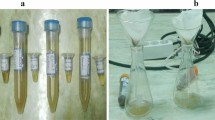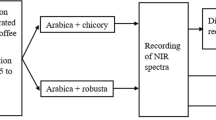Abstract
The recognition of the characteristics of coffee associated with a given agricultural system and aimed at adding value and attending the consumers’ demands stimulates the production of types of coffee properly described. The objective of this study was to explore and to explain the physicochemical characteristics and sensory attributes of the coffee grown in Parana State (Southern Brazil) based on an integrated approach of the terrior and the application of artificial neural network. Physicochemical variables of green coffee beans and roasted coffee beans were determined, as well as sensory attributes of the beverage. One hundred and seventy-two coffee samples were analyzed for moisture, proteins, chlorogenic acids, tannins, total acidity, total lipids, caffeine, total and reducing sugars and minerals. These properties were tabulated and presented to artificial neural network multilayer perceptron to be identified as the region and the city of planting. The artificial neural network classified correctly and tested 100% of the samples grown by region. For the database containing information by city, the automatic mode of the software Statistica 9.0 was used. The neural network showed 99% accuracy in training and 100% accuracy in the stage of testing and validation.







Similar content being viewed by others
References
Bishop CM (1995) Neural networks for pattern recognition. University Oxford, Oxford
Haykin S (2001) Redes neurais: princípios e práticas. Bookman, Porto Alegre
Hair JF Jr, Anderson RE, Tatham RL, Black WC (2005) Análise fatorial. In: Análise Multivariada de Dados, 5ª ed. Bookman, Porto Alegre
Melssen W, Wehrens R, Buydens L (2006) Supervised Kohonen networks for classification problems. Chemom Intell Lab Syst 83:99–113
Kovács ZL (1996) Redes neurais Artificiais: Fundamentos e Aplicações. Acadêmica, São Paulo
Mukesh D (1996) Applications of neural computing for process chemists: I. Introduction to neural network. J Chem Educ 73:431–433
Linder R, Pöppl SJ (2003) A new neural network approach classifies olfactory signals with high accuracy. Food Qual Preference 14:435–440
Deisingh AK, Stone DC, Thompson M (2004) Applications of electronic noses and tongues in food analysis. Int J Food Sci Technol 39:587–604
Liao S (2005) Expert system methodologies and applications—a decade review from 1995 to 2004. Expert Systems Appl 28:93–109
Hammond MH, Riedel CJ, Rose-Pehrsson SL, Williams FW (2004) Training set optimization methods for a probabilistic neural network. Chem Intell Lab Syst 71:73–78
Braga AP, Carvalho ACPLF, Ludermir TB (2000) Redes Neurais Artificiais: Teoria e Aplicações, 1st edn. LTC, Rio de Janeiro
Azevedo FM, Brasil LM, Oliveira RCL (2000) As Redes Neurais com Aplicações em Controle e em Sistemas Especialistas, 1st edn. Bookstores, Florianópolis
Hunter A, Kenedy L, Henry J, Fergunsom I (2000) Application of neural networks and sensitivity analysis to improved prediction of trauma survival. Methods Programs Biomed 62:11–19
Serra F, Guillou CG, Reniero F, Ballarin L, Cantagallo MI, Wieser M, Iyer SS, Héberger K, Vanhaecke F (2005) Determination of geographic origin of green coffee by component analysis of carbon, nitrogen and boron stable isotope ratios. Rapid Commun Mass Spectrom 19:2011–2015
Anderson K, Smith BW (2002) Chemical profiling to differentiate geographic growing origins of coffee. J Agric Food Chem 50:2068–2075
Bodt E, Cottrell M, Verleysen M (2002) Statistical tools to assess the reliability of self-organizing maps. Neural Netw 15:967–978
Looney CG (1996) Advances in feedforward neural networks: demystifying knowledge acquiring black boxes. IEEE Trans Knowl Data Eng 8:211–226
Ludermir TB, Yamazaki A, Zanchetin C (2006) Ann optimization methodology for neural networks weights and architectures. IEEE Trans Knowl Data Eng 17:1452–1459
Windeatt T (2006) Accuracy/diversity and ensemble MLP classifier design. IEEE Trans Neural Netw 17:1194–1211
StatSoft, Inc (2009) STATISTICA (data analysis software system), version 9.0. http://www.statsoft.com
Maeztu L, Sanz C, Andueza S, De Penã MP, Bello J (2001) Characterization of espresso coffee aroma by static headspace gc-ms and sensory flavor profile. J Agric Food Chem 49:5437–5444
De Maria CAB, Moreira RFA, Trugo LC (1999) Componentes voláteis do café torrado. Parte I: compostos heterocíclicos. Quim Nova 22:209–217
Grosch W (2001) Evaluation of the key odorants of foods by dilute experiments, aroma models and omission. Chem Senses 26:533–545
Mazzafera P (1999) Chemical composition of defective coffee beans. Food Chem 64:547–554
Clifford MN (1985) Chemical and physical aspects of green coffee and coffee products. In: Clifford MN, Wilson KC (eds) Coffee, botany, biochemistry and production of beans and beverage. Croom Helm, London, pp 305–359
Carvalho VD, Chagas SJR, Chalfoun SM, Botrel N, Juste ESG (1994) Relação entre a composição físico-química e química do grão beneficiado e a qualidade de bebida do café. Pesq Agropec Bras 29:449–454
BRASIL. Ministério da Agricultura Pecuária e Abastecimento. Instrução Normativa n° 8 de 11 June 2003
Instituto Adolfo Lutz. Métodos físicos químicos para análise de alimentos. Edição IV, 1ª edição digital, São Paulo, 2008
Clifford MN, Wight JC (1976) Chorogenic acids and other cinnamates nature, occurrence and dietary burden. J Sci Food Agric 27:73–84
AOAC—Association of Official Agricultural Chemists (1990) Official methods of analysis, 15th edn. Washington
Southgate DAT (1976) Determination of food carbohydrates. Applied Science Publishers, Londres
Pavan MA, Bloch MDM, Zempulsk HC, Miyazawa M, Zocoler DC (1992) Manual de análises químicas de solo e controle da qualidade. IAPAR, Londrina, Circular Técnica, n. 76
Basheer IA, Hajmeer M (2000) Artificial neural networks: fundamentals, computing, design, and application. J Microbiol Methods 43:3–31
Broyden CG (1970) The convergence of a class of double rank minimization algorithms: 2. The new algorithm. J Appl Math 6:222–231
Fletcher R (1970) A new approach to variable metric algorithms. Comput J 13:317–322
Goldfarb D (1970) A family of variable metric methods derived by variational means. J Comput Math 24:23–26
Shanno DF (1970) Conditioning of quasi-Newton methods for function minimization. Math Comput 24:647–650
Dai YH (2002) Convergence properties of the BFGS algoritm. SIAM J Optim 13:693–701
Fernandes SM, Pinto NAVD, Thé PMP, Pereira RGFA, Carvalho VD (2001) Teores de polifenóis, ácido clorogênico, cafeína e proteína em café torrado. Rev Bras Agrociência 7:197–199
Sarrazin C, Lequére JL, Gretsch C, Liardon R (2000) Representativeness of coffee aroma extracts: a comparison of different extraction methods. Food Chem 70:99–106
Illy A, Viani R (1996) Espresso coffee: The chemistry of quality, 2nd edn. Academic press, San Diego
Sivetz M, Desrosier NW (1979) Physical and chemical aspects of coffee. Coffee Technology, Westpor
Ginz M, Balzer HH, Bradbury AGW, Maier HG (2000) Formation of aliphatic acids by carbohydrate degradation during roasting of coffee. Eur Food Res Tech 211:404–410
Rogers WJ, Michaux S, Bastin M, Bucheli P (1999) Changes to the content of sugar, sugar alcohols, myo-inositol, carboxylic acid and inorganic anions in developing grains from different varieties of Robusta (Coffea canephora) and arabica (Coffea arabica) coffees. Plant Sci 149:115–123
Vasconcelos AL, Franca AS, Gloria MBA, Mendonça JCF (2007) A comparative study of chemical attributes and levels of amines in defective green and roasted coffee beans. Food Chem 100:26–32
Farah A, Monteiro MC, Calado V, Franca AS, Trugo LC (2006) Correlation between cup quality and chemical attributes of Brazilian coffee. Food Chem 98:373–380
Moon JK, Yoo HS, Shibamoto T (2009) Role of roasting conditions in the level of chlorogenic acid content in coffee beans: correlation with coffee acidity. J Agric Food Chem 57:5365–5369
Jiang D, Peterson DG (2010) Role of hydroxycinnamic acids in food flavor: a brief overview. Phytochem Rev 9:187–193
Frank O, Blumberg S, Kunert C, Zehentbauer G, Hofmann T (2007) Structure determination and sensory analysis of bitter-tasting 4-vinylcatechol oligomers and their identification in roasted coffee by means of LC-MS/MS. J Agric Food Chem 55:1945–1954
Montavon P, Duruz E, Rumo G, Pratz G (2003) Evolution of green coffee protein profiles with maturation and relationship to coffee cup quality. J Agric Food Chem 51:2328–2334
Acknowledgments
The authors are grateful to Fundação Araucária, UEL and IAPAR for their financial support.
Author information
Authors and Affiliations
Corresponding author
Rights and permissions
About this article
Cite this article
Borsato, D., Pina, M.V.R., Spacino, K.R. et al. Application of artificial neural networks in the geographical identification of coffee samples. Eur Food Res Technol 233, 533–543 (2011). https://doi.org/10.1007/s00217-011-1548-z
Received:
Revised:
Accepted:
Published:
Issue Date:
DOI: https://doi.org/10.1007/s00217-011-1548-z




